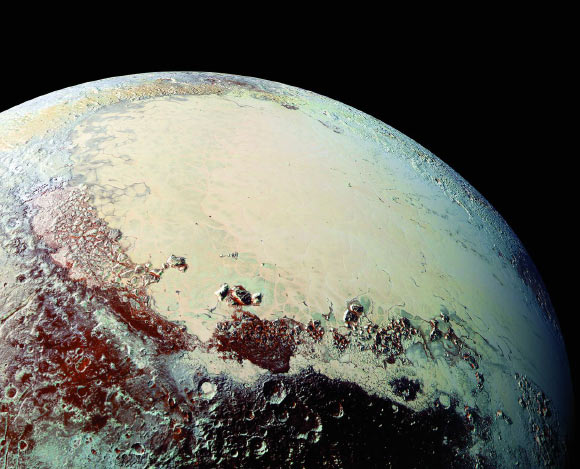When NASA’s New Horizons robotic spacecraft flew by Pluto in July 2015, it revealed clues that the enigmatic dwarf planet might have – or had at one time – a liquid ocean under its frozen surface. According to a new study published in the journal Geophysical Research Letters, such an underground ocean likely still exists today.

This Pluto mosaic was made from New Horizons LORRI images taken on July 14, 2015, from a distance of 49,700 miles (80,000 km). This view is projected from a point 1,118 miles (1,800 km) above Pluto’s equator, looking northeast over the dark, cratered Cthulhu Regio toward the bright, smooth expanse of icy plains called Sputnik Planum. Pluto’s North Pole is off the image to the left. This mosaic was produced with panchromatic images from the New Horizons LORRI camera, with color overlaid from the Ralph color mapper onboard New Horizons. Image credit: S.A. Stern et al, doi: 10.1126/science.aad1815.
The study, which used a thermal evolution model for Pluto, found that if the dwarf planet’s ocean had frozen into oblivion millions or billions of years ago, it would have caused the entire planet to shrink.
But there are no signs of a global contraction to be found on Pluto’s surface. On the contrary, New Horizons showed signs that Pluto has been expanding.
“Thanks to the incredible data returned by New Horizons, we were able to observe tectonic features on Pluto’s surface, update our thermal evolution model with new data and infer that Pluto most likely has a subsurface ocean today,” said lead author Noah Hammond from Brown University.
The images New Horizons beamed back from its close encounter with Pluto showed that the dwarf planet was much more than a simple snowball in space. It has a surface made from different types of exotic ices — water, nitrogen and methane.
It has mountains hundreds of feet high and a vast heart-shaped plain. It also has giant tectonic features — sinuous faults hundreds of miles long as deep as 2.5 miles (4 km). It was those tectonic features that got planetary researchers thinking that a subsurface ocean was a real possibility for Pluto.
“What New Horizons showed was that there are extensional tectonic features, which indicate that Pluto underwent a period of global expansion,” Hammond said.
“A subsurface ocean that was slowly freezing over would cause this kind of expansion.”
But if Pluto had an ocean, what is its fate today? Could the freezing process still be going on, or did the ocean freeze solid a billion years ago?
That’s where the thermal evolution model run by Hammond and co-authors comes in.
The model includes updated data from New Horizons on Pluto’s diameter and density, key parameters in understanding the dynamics in Pluto’s interior.
The model showed that because of the low temperatures and high pressure within Pluto, an ocean that had completely frozen over would quickly convert from the normal ice we all know to a different phase called ice II.
Ice II has a more compact crystalline structure than standard ice, so an ocean frozen to ice II would occupy a smaller volume and lead to a global contraction on Pluto, rather than an expansion.
“We don’t see the things on the surface we’d expect if there had been a global contraction. So we conclude that ice II has not formed, and therefore that the ocean hasn’t completely frozen,” Hammond said.
“There are a few caveats. The formation of ice II is dependent on the thickness of Pluto’s ice shell,” the scientists said.
Ice II only forms if the shell is 160 miles (260 km) thick or more. If the shell is thinner than that, the ocean could have frozen without forming ice II. And if that were the case the ocean could have frozen completely without causing contraction.
However, there’s good reason to believe that the ice shell is more than 160 miles.
The team’s model suggests that Pluto’s ice shell is actually closer to 186 or more miles (300 km) thick. In addition, the nitrogen and methane ices that New Horizons found on the surface bolster the case for a thick ice shell.
“Those exotic ices are actually good insulators. They may be helping Pluto from losing more of its heat to space,” Hammond said.
Taken together, the new model bolsters the case for an ocean environment in the furthest reaches of the Solar System.
_____
Noah P. Hammond et al. Recent Tectonic Activity on Pluto Driven by Phase Changes in the Ice Shell. Geophysical Research Letters, published online June 15, 2016; doi: 10.1002/2016GL069220







